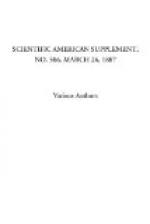In the present paper I shall deal principally with the chemical department of this subject, and shall briefly introduce, where necessary, allusion to the mechanical and electrical details connected with the process. At a future time I shall be glad to enlarge upon this part of the subject, with a view of making the article complete.
A short time ago nickel plating was nearly as expensive as silver plating. This is explained by the fact that only a few people, at least in this country, were expert in the mechanical portions of the process, and only a very few chemists gave attention to the matter. To this must be added that our text-books were fearfully deficient in information bearing on this subject.
The salt used, and also the anodes, were originally introduced into this country from America, and latterly from Germany. I am not aware of any English manufacturer who makes a specialty in the way of anodes. This is a matter on which we can hardly congratulate ourselves, as a well known London firm some time ago supplied me with my first experimental anodes, which were in every way very superior to the German or American productions. Although the price paid per pound was greater, the plates themselves were cheaper on account of their lesser thickness.
The texture of the inner portions of these foreign anodes would lead one to infer that the metallurgy of nickel was very primitive. A good homogeneous plate can be produced, still the spongy, rotten plates of foreign manufacture were allowed the free run of our markets. The German plates are, in my opinion, more compact than the American. A serious fault with plates of earlier manufacture was their crumpled condition after a little use. This involved a difficulty in cleaning them when necessary. The English plates were not open to this objection; in fact, when the outer surfaces were planed away, they remained perfectly smooth and compact.
Large plates have been known to disintegrate and fall to pieces after being used for some time. A large anode surface, compared with that of the article to be plated, is of paramount importance. The tank should be sufficiently wide to take the largest article for plating, and to admit of the anodes being moved nearer to or further from the article. In this way the necessary electrical resistance can very conveniently be inserted between the anode and cathode surfaces. The elimination of hydrogen from the cathode must be avoided, or at any rate must not accumulate. Moving the article being plated, while in the bath, taking care not to break the electrical contacts, is a good security against a streaky or foggy appearance in the deposit.
At one time a mechanical arrangement was made, by which the cathodes were kept in motion. The addition of a little borax to the bath is a great advantage in mitigating the appearance of gas. Its behavior is electrical rather than chemical. If the anode surface is too great, a few plates should be transferred to the cathode bars.




